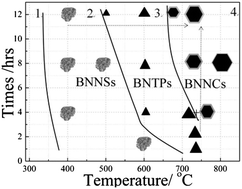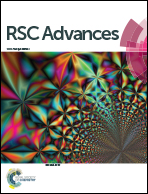From ultrathin nanosheets, triangular plates to nanocrystals with exposed (102) facets, a morphology and phase transformation of sp2 hybrid BN nanomaterials†
Abstract
In this study, an “autoclave route” was applied for the synthesis of 2D sp2 hybrid BN nanomaterials. By simply increasing the reaction temperature, a phase and morphology transformation occurs. The turbostratic BN nanosheets (BNNSs, 2–6 nm, 400–500 °C) transformed into the mixed phases (r-BN and h-BN) of triangular nanoplates (BNTPs) in the temperature range of 550–600 °C, and finally to h-BN nanocrystals (BNNCs, >730 °C). Interestingly, the intergrowths of r-BN and h-BN into the BNTP and BNNC plate was obtained in the range of 600–690 °C, which were determined via the selected area electron diffraction (SAED) pattern. Basically, the sizes (side length and thinness) of BNTPs and BNNCs can be tuned by adjusting the reaction temperature and time. The phase transformation temperature was much lower than that of previous reports. The in situ produced Fe nanoparticles, molten Na and autogenic pressure were considered to have positive effects on the phase transformation. Their band gap was estimated to be 5.6–5.8 eV according to the optical absorption spectrum, and Cathodoluminescence (CL) images show that as-synthesized BN nanomaterials had uniform optical properties in the ultraviolet region. Besides, the Ag–BN composite showed excellent antibacterial activities and therefore has potential applications in biomedical and related fields.


 Please wait while we load your content...
Please wait while we load your content...